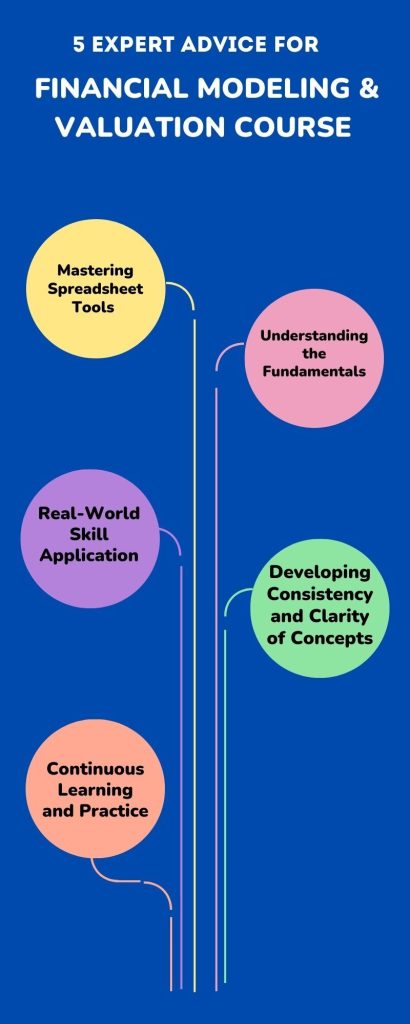Financial models have seamlessly integrated into business operations and are now considered essential tools for companies. Despite their widespread use in enhancing productivity and aiding in decision-making.
This is a how-to guide for students with expert tips for them to understand our financial modeling courses more. Several corporate management teams depend on financial models for everyday functioning. These models provide vital details, assumptions, and outputs and play a crucial role in shaping the strategic and capital decision-making processes of companies.
When dealing with complex tasks, the initial and essential step in constructing a financial model is meticulous planning and blueprinting. Unexpected structural modifications in the middle of a modeling project can be a time-consuming and error-prone process, particularly when the individual adapting the model is not the same as its original author.
In this blog, we will discuss about 5 expert tips for Financial Modeling & Valuation Course. The tips are-

1.Mastering Spreadsheet Tools
Excel is the backbone of financial modeling. Invest time in becoming proficient with functions, formulas, and keyboard shortcuts. This will not only save you time but also make your models more accurate and efficient.
Consider enrolling in our Financial Modeling & Valuation courses and learn more about how to use spreadsheets effectively.
- Advanced Formulas: Learn and practice advanced functions and formulas, such as VLOOKUP, HLOOKUP, INDEX-MATCH, and nested IF statements.
- Keyboard Shortcuts: Familiarize yourself with keyboard shortcuts to enhance your efficiency, like Ctrl+C, Ctrl+V, Ctrl+Z, and Ctrl+Shift+Arrow keys.
- Data Validation and Error Checking: Use data validation to ensure data accuracy and implement error-checking techniques to spot and correct errors quickly.
- Formatting Skills: Improve your formatting skills to present data clearly and professionally. This includes using custom number formats, conditional formatting, and cell styles.
2. Understanding the Fundamentals
Before diving into complex financial models, ensure you have a solid grasp of the underlying financial concepts. This includes understanding financial statements, accounting principles, and valuation techniques. A strong foundation is crucial.
CFI Education Financial Modeling & Valuation Course will help you gain industry-related knowledge in a short period to boost your knowledge.
- Financial Statements: Start with a deep understanding of financial statements – balance sheet, income statement, and cash flow statement. Learn how they are interrelated and used for analysis.
- Accounting Principles: Familiarize yourself with basic accounting principles, such as accrual accounting and the matching principle, which are essential for financial modeling.
- Time Value of Money (TVM): Learn TVM concepts, including present value, future value, and discounting, as they are foundational for valuation and cash flow analysis.
Valuation Techniques: Explore various valuation methods, such as discounted cash flow (DCF), comparable company analysis (CCA), and precedent transactions analysis (PTA).
3. Real-World Skill Application
Try to relate your models to real-world scenarios. Consider various industries and companies to understand how different variables impact financial performance. Practical examples and case studies can provide invaluable insights.
CFI Education provides you with a platform where you learn through our Financial Modeling & Valuation courses. These tell you how to practically apply your knowledge by building financial models.
- Competitor Analysis: Analyze competitors to benchmark performance and understand the industry context. This helps in making more accurate assumptions.
- Scenario Analysis: Create multiple scenarios to model different future outcomes. Consider best-case, worst-case, and base-case scenarios to account for uncertainty.
- Sensitivity Analysis: Test the sensitivity of your model to different variables. This helps you identify which assumptions have the most significant impact on outcomes.
- Risk Assessment: Incorporate risk factors and risk mitigation strategies into your model. Understand how changes in assumptions or external factors can affect risk.
4. Developing Consistency and Clarity of Concepts
Maintain consistency in your models. Use clear and standardized labels for variables, assumptions, and formulas. This not only makes your work easier to follow but also helps avoid errors.
At CFI Education, we offer live sessions and online classes in our Financial Modeling & Valuation courses. These help you learn better at your own pace.
- Learn from Feedback: When you receive feedback on your models, use it as an opportunity to improve your consistency and clarity.
- Clear Documentation: Always document your assumptions, formulas, and methodology within your model.
- Check for Errors: Develop the practice of thoroughly checking your models for errors.
Consistent Formatting: Apply consistent formatting throughout your model.
5. Continuous Learning and Practice
Financial modeling is a skill that improves with practice. Work on different types of models, take on challenging projects and seek feedback from professors or mentors. Continuous learning and refinement are keys to becoming an expert.
- Hands-On Practice: Actively work on financial models. The more you practice, the more comfortable and proficient you become. Start with basic exercises and then move to real-world applications.
- Diverse Models: Don’t limit yourself to one type of financial model. Work on a variety of models from our Financial courses.
- Real-World Data: Whenever possible, use real-world data to build your models. This will make your learning experience more authentic and applicable to practical situations.
Challenge Yourself: Take on challenging projects and models that push your boundaries. Tackling complex scenarios and industries can be demanding but incredibly educational.
Conclusion
Mastering the art of financial modeling is a journey that requires dedication. To excel in financial modeling courses as students, we’ve explored five invaluable tips from seasoned experts. By embracing these tips, students can pave the way to academic success. More importantly, a prosperous career in the dynamic world of finance.
Frequently Asked Questions (FAQs)
Why is Excel proficiency important in financial modeling courses?
Excel is the most widely used tool for financial modeling. Proficiency in Excel is crucial for creating, analyzing, and presenting financial models effectively.
How can I enhance my understanding of financial fundamentals?
You can improve your understanding of financial fundamentals through online courses, textbooks, and educational resources specific to finance and accounting. Additionally, consider enrolling in financial modeling courses.
What industries benefit from financial modeling skills?
Financial modeling skills are valuable across a wide range of industries, including investment banking, corporate finance, private equity, real estate, and more. These skills are applicable wherever financial data analysis is necessary.
How can I ensure that my financial models are consistent and clear?
To ensure consistency and clarity, use standardized labels, clear documentation, organized structures, and logical flows in your models. These practices make your models more understandable and less error-prone.



